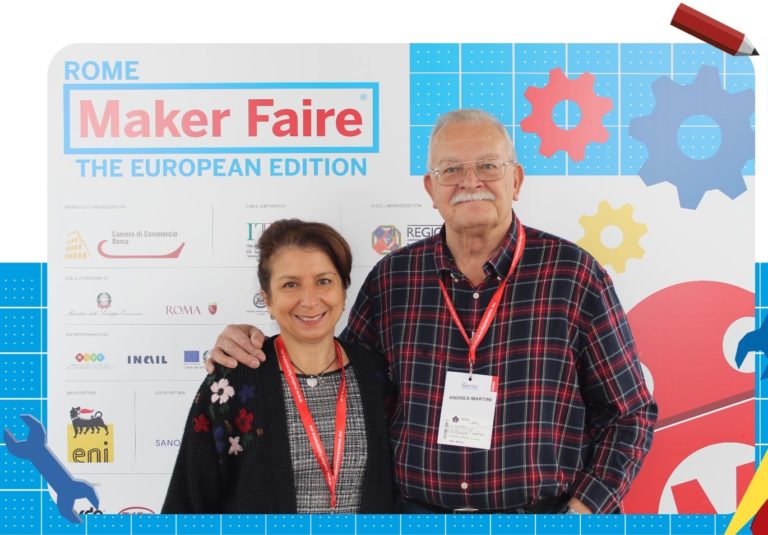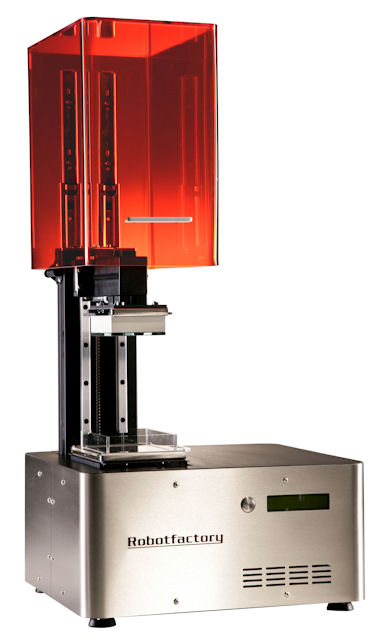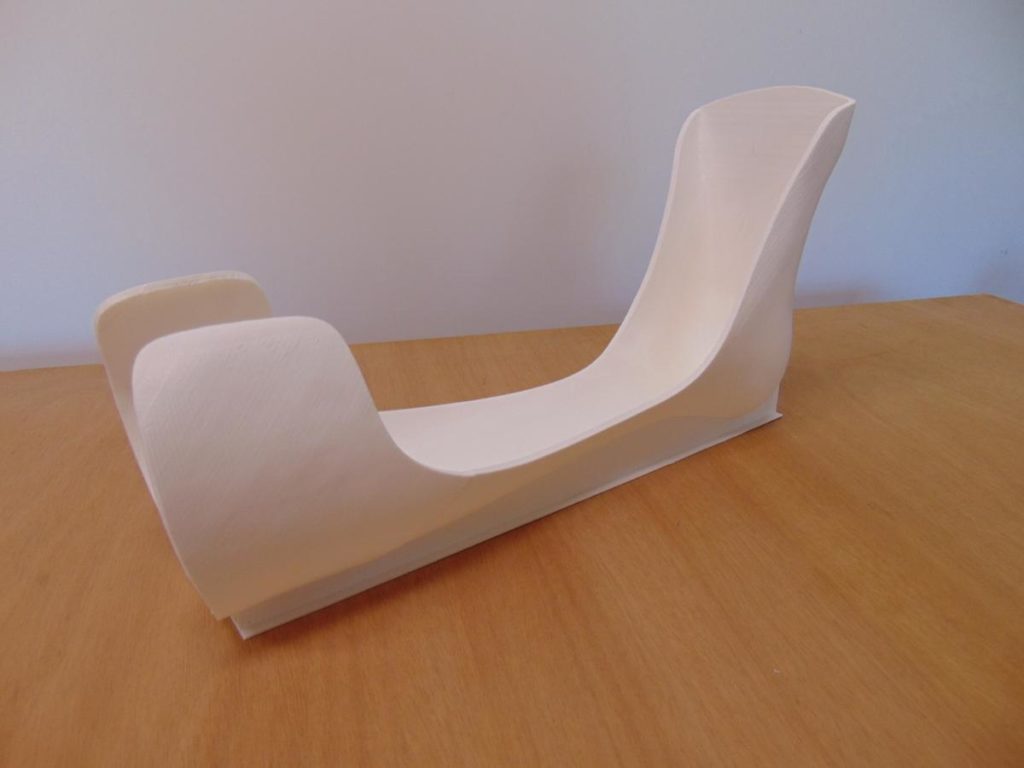A few years ago in around 2012 I started to see some innovative 3D printers emerge from a workshop in Venice. These RobotFactory.it printers showed a lot of craftsmanship, tight tolerances and high-quality parts & finishing. I was blown away the first time I saw one. Most desktop machines at the time we rather rickety and here was a solid, beautiful metal block of a thing that I instantly fell in love with. From what I heard the printers worked well also, which was nice for a change. They were robust and you could feel from every surface and fastener that these were machines built to last. Afterward, DLP printers and a belt based FDM system also emerged from Venice. For eight years now RobotFactory.it has been making great machines but it has rarely been featured in the press. Owner Andrea Martini had been making robots and CNC machines since 2002 and used this knowledge to make high quality desktop 3D printers in Italy. We interviewed Andrea Martini to find out more.

Since when have you been making 3D printers?
We’ve developed and produced 3D printers, since 2011.
Why did you start?
In the early years, 3D printers had excessive costs and they were the exclusive privilege of big companies. We used our many years of experience in the CNC field, to realize a new goal, to offer affordable professional 3D printers on the market. Today Robot Factory is proud to produce, several high quality and performance 3D printers.

What did you do before?
As early as 2001 Robot Factory designed and produced the first educational robots, equipped with a programmable motherboard, manufactured and sold in assembly kits.
Later, Robot Factory, the first on the market, created a CNC system to be assembled, with the aim of making the use numerical control machines available to an increasingly wider public. Since 2002 for several years Robot Factory has designed, produced and sold several CNC systems, mostly produced and distributed in assembly kits.
What kind of systems do you make?
The first 3D printer that we developed, was the 3D-ONE (material extrusion 3D printer, manufactured and sold until May 2014), since May 2013, we started the production of the 3DLPrinter series (stereo-lithographic printers) followed by the 3DLPrinter-HD models. Today Robot Factory manufactures and sells three different models of 3D printers:
3DLPrinter-HD 2.0+ (fourth generation) – a professional stereolitographic printer with DLP © technology that uses a special photosensitive polymer resin to create objects with high definition print details.
Sliding-3D is the professional FFF 3D printer equipped with an “infinite” printing plane, that makes this 3D printer particularly suitable both for serial production of small items as well as for 3D printing of large objects. The most distinguishing feature of Sliding-3D is the build volume (410mm x 380mm x ∞ – endless), because the printing plane is a sliding belt, this means it can be engaged in an “uninterrupted” work cycle. It has many features that can attract the most demanding users, firstly, the printing plane to infinity, to make easy the production of small series and 3D printing of long items (theoretically unbounded in length).
After several successful projects produced and sold in kit since the first years of our activity and using our long-lasting experience in the 3D printer industry, in the last months we’ve offered the Silver Belt, FDM-45 3D printer equipped with the sliding printing bed and the 45° inclined extruder, achievable through an “all-metal mounting kit”. The first and only kit to assemble a 3D printer that does not require plastic parts previously printed!

Your systems seem very robust?
We do everything it’s possible to ensure that every 3D printer produced by us it is engineered to the highest standards, beyond what is required by any national and international certification. We make machines engineered with extreme care in the mechanics and electronics contained in them, resulting in particularly solid, precise and long-lasting 3D printers.
Video showing the Silver Belt printing 100% infill PPS CF.
Who are they meant for?
At Robot Factory we have always been aware of the strategic value of the investing in the Futur. As proof of this, you can see the many projects developed in the course of our long experience. We are continuing, year after year, spending our energies on innovative, new projects, that result in products, engineered with the utmost attention to detail, meant to be valid and durable instruments in successful contexts. Our 3D printers are meant for production of concept and functional prototypes, manufacturing tools, replacement parts, designer support tools, etc.

What kind of customers do you have?
Actually we have always had customers who make professional use of our machines, medium-large companies and some craftsmen who have evolved in their work by adopting the new technologies to support their work process. With this last project, Silver Belt kit, we reduced the purchase costs for the end customer and make the machine easily transportable, thus also we reduced the shipping costs, only in this way we can easily reach anyone who wants to take advantage of the great opportunities of the continuing 3D print, all over the world! If you want to know your 3D printer in all the details, and at the same time you want to take advantage of the great chances offered by the use of the FDM-45 technology, using the “Silver Belt” kit you will have the opportunity to build a 3D printer that has the functional features of the “Sliding-3D” professional printer, but being able to modify each part according to your needs! …and when you finally use it, the experience will be much more rewarding, since you will really know every detail, but with the guarantee that every part has been perfectly engineered taking advantage of Robot Factory solid experience in developing this innovative technology.
Why should I buy a printer from you?
Because we believe in the great potential of this industry, but we know and understand the concerns of who approaches new technologies and we would never build anything in which we do not believe 100%. Because any of our products is the result of a philosophy that we always follow with constancy: ensure maximum performance and the best possible longevity to our products.

TPU on a Silver Belt
Tell me about your DLP system?
The 3DLPrinter-HD 2.0+ (fourth generation) is able to achieve amazing results, as it allows to achieve an extraordinary surface quality with extremely fine details. The used prototyping technique DLP© is the system of 3D printing that uses photosensitive polymer resin. The printer keeps the most interesting peculiarity of the previous model, the high speed, obtained through the adoption of a particular movement of the resin vat, which allows a rapid solidification of the whole layer in one operation. Over the years we have sold many printers of this series, especially in the jewellery industry (where detail is the fundamental customer request), but another sector where our DLP printers are used is the research, a field from which we received great satisfaction. The reason why our DLP 3D Printer has been adopted by many teams of university researchers (or industrial researchers) is that it can easily be used to test new materials.
Unfortunately, however, for some years now the market has seen LCD technology join the stereolithography market and a lot of competitors appeared in this industry, with the consequence that the market has become a jungle where the customer has a hard time finding to choose his own 3D printer according to own needs.
We didn’t adopt this new lower-cost technology, because it does not guarantee the longevity of the 3D printer, because the LCD tends to deteriorate in a short time.
I was blown away by your Robot Factory 3d one a few years ago. How did it come about?
3D-ONE was the first 3D printer that we have engineered. I was among the firsts manufacturers in Europe who believed that this technology had to be made available to an increasingly wider audience of users, so I engineered a well made and inexpensive Extruder and the adventure began! Thanks to my experience in the CNC field, which we were producing from some years, that extruder was mounted on a four-axis system and so my first material extrusion 3D printer was born.

An orthopedic brace made on the Silver Belt
How do your sliding systems work?
The most distinguishing feature of our sliding belt 3D Printers, both the Sliding-3D (Standard and Plus) and Silver Belt, is the endless Z-axis, which means you can handle an uninterrupted work cycle to make prints of various 3D objects, with any 3D print length that you can imagine. Here it’s how these 3D printers work: the machine is a non-orthogonal coordinate system in which the construction plan does not coincide with the adhesion plan of printing object. The X-Y plan is inclined on the Z axis. So, it prints any layers to a fixed angle from the Z axis. This feature, along with Z axis that is a moving belt, it allows the build platform shifts itself continually with respect to the extruder. This one is inclined in turn (at a fixed angle) relative to the build platform. This system allows you to print ‘in a continuous way’.
Who is buying them?
This technology can create accurate functional prototypes, manufacturing aids, customized objects, medical aids, parts for design checks, including for mechanical engineering, because it is suitable both for serial production of small items as well as for 3D printed long objects.
Our customers are:
specialized partner companies to completely follow the customer’s projects, from the initial idea to the delivery of the finished product;
companies engaged in the manufacture of measurement and regulation equipment, precision instruments, production tools;
companies engaged in the automotive industry;
companies that produce components for the domestic appliance sector;
some of our customers develop and produce functional parts, components and engineering systems for machines and plants, for mining, the automotive industry and other important industrial branches;
companies that performs services and spare parts production for Aerospace industry;
companies that produce packaging systems;
companies that design, assemble and commercialize hardware for various fields.
What kind of parts do they make?
Our customers make: concept and functional prototypes, manufacturing tools, replacement parts, designer support tools, etc.
What is the advantage?
Using Sliding-3D or Silver Belt, when a continuous printing batch is running, any time that a job is completed, a new job starts automatically and the printing goes on. During the printing job the belt goes forward until the printed object, reaching the front roller, detaches itself from the same belt. In this way, the items can be collected in a container in front of the roller.
Exploiting at the same time the endless print bed, the inclination of the printing layers and the layers translational function, Sliding-3D and Silver Belt can reduce up to 100% the support structures (for the ‘overhangs’) usually needed to print using the other 3D printers. This means the extraordinary benefit of saving time and material used for the same print and drastically reducing post-processing times (usually required for the removal of any support structures and for the finishing of the printed part).
Sliding-3D has a special print bed made using a composite material, it does not require any preparation (glue, spray, adhesive belt, etc.), because it prevents the possible detachment of the model during the printing phase and favors the detachment at the end of printing phase. In addition, it’s available a special “Box” for protection and insulation, engineered to ensure compliance with the functional characteristics of the Sliding-3D printer. The “Box” creates a printing environment that is isolated respect to the place where the printer is used, both for temperature and for dust.
What is holding our market back?
Confusion around the technologies, little knowledge of the advantages / disadvantages of the various technologies on the market, the manufacturer’s competition hinging on the reduction of the final price to the complete disadvantage of the quality of the printers proposed to the customer.
Subscribe to Our Email Newsletter
Stay up-to-date on all the latest news from the 3D printing industry and receive information and offers from third party vendors.
You May Also Like
3D Printing Financials: Fathom Struggles in Financial Quicksand During Critical Transition
Facing a year of key transitions and financial pressures, Fathom (Nasdaq: FTHM) has filed its annual report for 2023 with the U.S. Securities and Exchange Commission (SEC). The document outlines...
Latest Earnings Overview for Australian 3D Printing Firms Titomic and AML3D
Australian 3D printing manufacturing firms Titomic (ASX: TTT) and AML3D (ASX: AL3) reported their financial results for the period from July to December 2023, marking the first half of their...
3D Printing Webinar and Event Roundup: April 7, 2024
Webinars and events in the 3D printing industry are picking back up this week! Sea-Air-Space is coming to Maryland, and SAE International is sponsoring a 3D Systems webinar about 3D...
3D Printing Financials: Unpacking Farsoon and BLT’s 2023 Performance
In the Chinese 3D printing industry, two companies, Farsoon (SHA: 688433) and Bright Laser Technologies, or BLT (SHA: 688333), have recently unveiled their full-year earnings for 2023. Farsoon reported increases...































